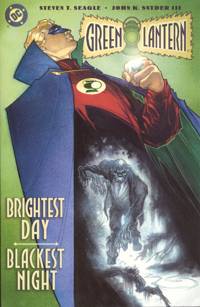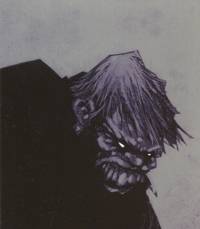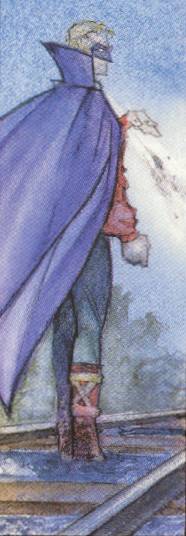Green Lantern: Brightest Day, Blackest Night
By Hervé St-Louis
December 31, 2002 - 10:21
DC Comics
Writer(s): Steven T. Seagle
Penciller(s): John K. Snyder III
Inker(s): John K. Snyder III
Colourist(s): John K. Snyder III
Cover Artist(s): John K. Snyder III
 |
Green Lantern Brightest Day, Darkest Night (BDBN) is a 48-page graphic novel retelling the classic first encounter of the Golden Age Green Lantern Alan Scott with his arch nemesis, Solomon Grundy. The writing is by Steven T. Seagle. The artwork is by John K. Snyder III. The excellent lettering is by Todd Klein.
Grundy is a chalky ogre created of decaying body parts and debris in Slaughter Swamp just outside of Gotham City. The catch about Grundy is that being partially composed of wood. It protects him from Green Lantern's power ring which cannot affect wood.
 |
Unlike the original story, where Green Lantern met and fought Grundy, in BDBN the meeting of the two enemies is tied with a plot by local Nazi supporters to kidnap the inventor of a new doomsday device. The kidnappers and the inventor crash a highjacked plane in Slaughter Swamp. It's up to Green Lantern and his two sidekicks, Doiby Dickles and Irene Miller to foil the Nazi's menace and contain Grundy.
The major problem with this new story is that it tries to fit everything within the context of current continuity. Because this story is given the treatment of a special graphic novel, Seagle saw fit to include as much back story about the Green Lantern, Grundy and the Justice Society as possible.
'Sunday Sunday Sunday'
 |
The inclusion of the Justice Society so prominently in the story is farfetched. Besides emphasizing the characters' iconic presence visually and with a couple of "meaningful" comments, they added nothing to the story. And if Seagle was going for the continuity effect, it appears that his history and the exact lineup chosen do not match the original story and context.
By trying to create the definitive Golden Age Green Lantern story, Seagle compresses all of the characters' continuity within this story. Alan Scott arrival in Gotham City is forcefully tied with Grundy. Scott's two sidekicks meet for the first time within this story. Slaughter Swamp is once and for all associated with Gotham City. Grundy's obsession with Green Lantern is presented as fully developed.
In the story, the concept of light and dark are symbolized by Green Lantern and Solomon Grundy. Green Lanterns, past and present being symbolized as defenders from the forces of light and good combatting the dark and evil is not new. However, the visual interpretation of the concept in BDBN, by Snyder is one of the best in Green Lantern history. The illustrations are rich and meaningful.
The perversion of the light generating Zeta Wave, the doomsday weapon stolen by the Nazis, is ironic. The Zeta Wave is a light generating engin designed to help the Allies defeat the evil and dark Nazis. Yet under the Nazis, the weapon is used equally against evil in the form of Solomon Grundy and Green Lantern, the untouchable symbol of good.
 |
Here are some comments by Green Lantern fan Sk8maven.
Very interesting, and I agree with a lot of it (including that the story ultimately fell short of its intended goals). However, you are dead-wrong about the relationship between Alan Scott and Irene Miller. There was nothing "pseudo" about it. He made an overt pass at her the second time they ever met (see the conclusion of the GL strip in Al-American #18). They had a hot and heavy flirtation going on as long as Irene was in the strip at all. They most certainly DID date (see All-American #31, when Alan takes Irene to the charity ball). And he kissed her both as GL (GL #1, "The Adventure of the Masquerading Mare") and as Alan Scott (GL #3, "The Living Graveyard of the Sea").
The reason for her disappearance from the strip, and from Alan's life, has never been told. We finally get a hint, in "Brightest Day, Blackest Night", that their careers started pulling them in different directions - notice that at the end Irene is headed back to the city they came from (whouch would have been "Capitol City", i.e. Washington, DC), but it is implied that Alan is not going with her.
Works a lot better than arbitrarily killing her off.
Maven
Related Articles:
Golden Age Green Lantern
History of the Golden Age Green Lantern
